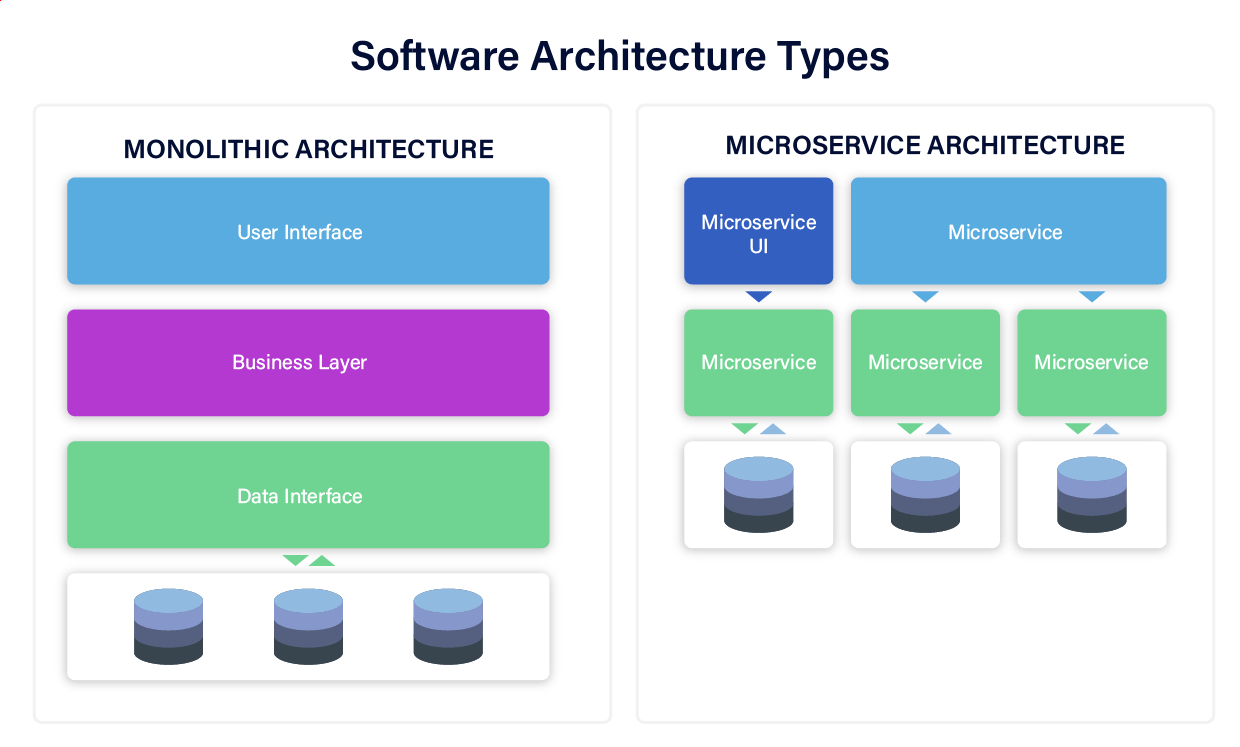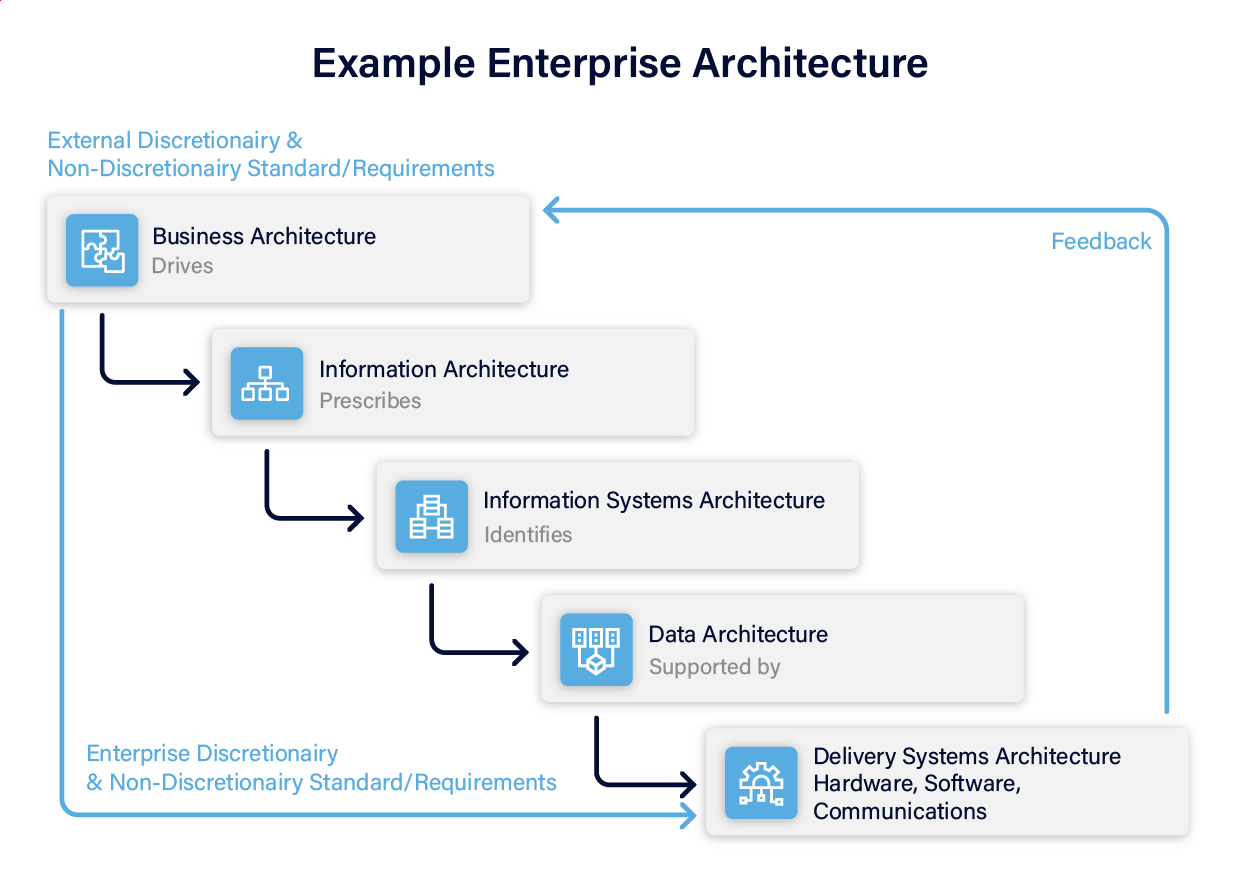

Enterprise architect vs. solution architect vs. technical architect: Key differences
Ubiquitous digitalization has revolutionized our lives and is rapidly altering human society and the very world around us. One of the spheres undergoing the most significant transformations is our language. Just a few years ago, user interface, plugin, AWS, CRM, outsourcing, and other words and acronyms were known only to a limited number of high-fi specialists, while today, the majority of laymen who own a gadget operate them quite easily.
However, technical progress in the IT realm not only introduced new words into the vocabulary but also changed the meaning of familiar ones. In the mind of most people of the early second millennium, a platform is hardly associated with railroads, cookies are never kept in a jar, a tool is something more than a hammer, and a cloud is what cannot be seen when you look at the sky above.
An Architect is one such term. When we hear that the IT department hired a solution architect and a technical architect, we do not imagine a person wearing a hard hat who argues with the construction foreman over a building project. Even if such architects have something to do with sites, the latter are never places where a building is being erected.
Are you looking for specific tech skills? We provide IT staff augmentation services. And here’s a complete list of questions and answers about outstaffing that might interest you – Check the list!
Software architects: What they are and what they are not
Software architecture is a skeleton of the respective infrastructure whose characteristics ensure flexibility, scalability, and security of the entire system, which must function according to business and technical requirements. Like any other system, software architecture presupposes the existence of the elements and the structure that subsumes relations and connections. Thus, an IT or software architect is to translate all necessary characteristics into a solution blueprint shaping its components and defining communication and coordination between them. How do they go about it?
At first, the architect is to realize what the customers expect to get, that is, functional and quality requirements for the finished product since it is crucial for the future structure of the solution they are to work on. Being aware of such data, the architect figures out what structural elements will compose the system and defines how they will collaborate. After that, all the components are united into a larger system and brought into line with major business goals. In case the qualified specialist does their job by the book but with a dash of creativity, the final product will be a top-notch solution where business risks are kept to a minimum and functionality lives up to the customer’s expectations.
Software architecture is sometimes confused with software design. While having a common overarching goal (that is, obtaining a robust solution that delivers), these two have their own role in reaching the ultimate destination. Anatomically speaking, software architecture provides a backbone to which muscles and ligaments are attached, whereas software design focuses on the tissues that provide adequate functioning for the whole organism.

Read more about software architecture types: Monolithic vs microservices architecture: Which is better?
Software designers deal closely with the structure and development of the elements, taking care of coding, integration, design per se, and subsequent testing. Thus, it is the designers who implement the blueprint compiled by architects in accordance with the customer’s requirements. While doing this, they:
- Produce software requirements specifications – a document that explicates how the system will behave when it interacts with hardware it is installed on, other software, and people who exploit it. These specifications must relate to business requirements forwarded by customers and agreed upon by architects.
- Provide high-level design. To attain it, the entire system is fragmented into subsystems and modules, with further implementation and projecting their connection with each other.
- Supply detailed design. At this stage, the organization of each module is handled with special attention to the scope of classes and the purposes of various functions.
As the explanation reveals, software architecture outlines the roadmap, which is then implemented through detailed software design of the solution, with a special focus on establishing algorithms and data structuring. Instead of juxtaposing the two procedures, it is more correct to consider the two stages of software development. Consequently, the functions of software architects and software designers often overlap, causing them to make decisions belonging to one another’s domains. Both domains are included in one system known as enterprise solution architecture.
Need to hire a software architect? Check out our IT staff augmentation services.
The elements of enterprise solution architecture
Today, any enterprise poised for financial success and expansion must leverage digital technologies to stay abreast of the swift pace of progress in all contemporary industries. When employed to cater to the needs of a particular enterprise, such frameworks are called enterprise solutions. The latter normallconsistsst of the information, technical, and business faces, united into a single architecture.

What are the components of modern enterprise solution architecture? Typically, they include ERP, CRM, SaaS, enterprise mobility, project and supply chain management, business intelligence, etc. Since our company has developed many business solutions, we know that their smooth integration and efficient functioning are expected to provide interoperability and sharing of information, the organization’s flexibility and agility, and business and technology alignment. The result of such improvements is sure to tell upon the enterprise’s productivity and enhance customer relationships, bringing a regular inflow of revenues into the company coffers.
Solution architecture vs system architecture
It is important not to confuse enterprise solution architecture and system architecture. Their juxtaposition can be performed not only in terms of specialists responsible for handling them (i.e., system architect vs enterprise architect). They are different in essence, though closely related. While solution architecture refers to the organization of software systems leveraged by a company, system architecture is understood as the physical placement of all software components on hardware.
Consequently, a system architect who understands the core relationships between IT system elements must make a crucial decision as to whether certain software should be located on the same or different servers (known as centralized and decentralized models). Organizations that have a high-speed server or solid storage facility may voice their preferences, but the ultimate choice always lies with the system architect. The outcome of this choice will condition the selection of various types of software architecture, which affects the performance and reliability of the solution in question.
With enterprise solution architecture being introduced on a large scale, the demand for software experts in the sphere displays a steady growing pattern conditioning the division of responsibilities within this professional group. In this article, we will showcase the differences between technical architect, solution architect, and enterprise architect, all of which nestle under the broad umbrella term of software architect.
Read more about enterprise software development
What does a solution architect do?
The solution architect is a visionary strategist. Having a broad understanding of technologies applied for various solutions and typically a degree in computer science, mathematics, or business (or several of them), they perform the functions of policymakers dealing with the task they are given. In military terms, they are generals who plan operations, producing guidelines to follow “from cradle to grave” for other parties to the process.
Having been assigned to a project, the solution architect assesses business requirements and offers the general concept of a technological solution that corresponds to them. Then they develop the detailed life cycle of the solution, consisting of several building blocks. Once it is done, solution architects are in charge of managing all processes that are called to see the project through by translating their concept into palpable technical steps and coordinating the activities of those who are involved in it.
Solution architects should be able to consider a broad scope of related issues when tackling a project. To ensure the optimum result, they research the topic to expose possible positive and negative developments, assess the efficiency of the chosen methods and techniques, and provide technical forecasts—in a word, they serve as chief consultants in the strategic planning of the entire organization.
The risks associated with the project are a matter of special concern for them. Solution architects must try to foresee the consequences of employing untested technologies, simultaneous usage of several tools, outsourcing the project to external developers, and shifting client requirements.
In fact, a solution architect acts much like a project manager who ensures that every involved stakeholder is on the same page and moving in the right direction at each stage of solution development, thus providing product consistency.
Before the project reaches the implementation phase, it should be submitted to an enterprise architect. What is the difference between a solution architect and an enterprise architect in terms of their responsibilities?
What does an enterprise architect do?
The difference between a solution architect and an enterprise architect lies in the scope of responsibilities. While the solution architect’s authority is limited by the project they are assigned to, the enterprise architect (as the name suggests) must take a broader view and check whether the solution strategy chosen by the solution architect is in accord with the company’s mission. To do that, the enterprise architect should be aware not only of the organization’s internal policies and goals but also of the environment.
The external factors that the enterprise architect tracks include the overall technological landscape in the world, current IT trends, and competitors’ advances in the field. Being in the know of such developments and having degrees in information systems or information technology, the enterprise architect determines how IoT, ML, or AI can be leveraged to give the organization a competitive edge and updates the IT department on the new frameworks, platforms, and practices of applying them.
Thus, if a CEO is contemplating what kind of software architect to hire, the opposition of enterprise architect vs solution architect is a faulty one. Each of them is a necessary summand of implementing the company’s IT strategy which renders the choice between enterprise vs solution architect non-existent since both are to do their bit for the well-being of the organization. What is common between these kinds of software experts is that both excel in seeing the entire picture, adopting a rather abstract view of structures and processes related to it. They hardly go into detail, which is the task of the third type of software specialists – technical architects.
Related article: Enterprise mobile application development: A detailed guide
What does a technical architect do?
Being strategically oriented, both enterprise and solution architects delegate specific tasks to other specialists. So once the overall planning is over, technical architects come into play. However, since every project is unique, a solution architect and a technical architect work in close cooperation to deliver the best result, providing a link between the strategic idea and its technical implementation. While executing an IT project, technical architects adopt a hands-on approach, which requires an exceptional level of in-depth proficiency. This requirement conditions two peculiarities of technical architect vs solution architect.
First, technical architects must have a degree in computer science, computer engineering, or software development. Moreover, mastery of the major programming language is a good crutch in their activities, and it is welcomed by all companies.
The second difference between a solution architect and a technical architect is that the latter conventionally specializes in one technology (rarely two of them). They are covered by the umbrella term “domain architects” and receive names in accordance with the sphere they work in – Java architect, Net architect, Sparx architect, Python architect, etc.
The duties of any domain architect, such as application architect vs solution architect, are very limited. Unlike the latter, who performs the functions of project managers, the former exercises supervision over development teams by defining standards they are to stick to in their work, estimating solution implementation costs, controlling project timelines, analyzing design specifications, envisaging potential risks and pitfalls, and ensuring the overall functionality of the finished solution. This effectively makes the technical architect a technical project manager.
Since the technology such specialists are well-versed in is likely to be employed across many projects of a company, technical architects tend to be involved in all those places, thus ensuring the smooth functioning of the IT framework around the entire venture.
Technical architect vs solution architect vs enterprise architect
To better understand the differences between the three architects, we offer the table below.
| Aspect | Technical Architect | Solution Architect | Enterprise Architect |
| Primary focus | Technical implementation and infrastructure | Designing specific solutions to business problems | Aligning IT strategy with business goals |
| Scope | Project-specific or component-specific | Solution-specific, often spanning multiple projects | Organization-wide, encompassing multiple solutions |
| Key responsibilities | – Ensure technical quality and standards – Develop detailed technical designs – Oversee code reviews and technical documentation | – Define architecture for a solution – Ensure the solution meets business and technical requirements – Collaborate with stakeholders and teams | – Develop and maintain enterprise architecture roadmap – Ensure IT alignment with business strategies – Govern and manage enterprise-wide architecture standards |
| Skills required | – Deep technical knowledge – Proficiency in programming and technical tools – Understanding of infrastructure and network design | – Strong understanding of both business and technology – Ability to design complex systems – Stakeholder management skills | – Strategic thinking – Broad understanding of various technologies – Ability to align IT and business strategies |
| Interaction with teams | Works closely with development and engineering teams | Collaborates with business analysts, project managers, and development teams | Engages with executive leadership, business units, and IT departments |
| Typical deliverables | – Technical design documents – Code guidelines – Performance benchmarks | – Solution architecture documents – High-level design documents – Integration plans | – Enterprise architecture frameworks – Technology roadmaps – Governance policies |
| Example tasks | – Designing system components – Ensuring performance and scalability – Conducting technical reviews | – Creating solution blueprints – Evaluating technology options – Ensuring compliance with requirements | – Defining enterprise standards and policies – Assessing emerging technologies – Driving digital transformation initiatives |
| Decision-making | Technical decisions at the project level | Architectural decisions for solutions | Strategic IT decisions across the enterprise |
The software engineer: Another stakeholder in the IT process
While comparing solutions or enterprise architects to technical architects, some people tend to believe that the latter builds software products (such as computer games or apps) and runs network control systems. This is not true since a technical architect acts as a manager supervising the people who do this. Such people are called software engineers (or developers). Alongside the enumerated responsibilities, their scope of activities encompasses designing, coding, unit and code regression testing, debugging, improving operation ability, performing logical configurations, upgrading, and modeling – in a word, everything that relates to the implementation of a concept developed by a technical architect.
As people’s reliance on IT technologies grows, the demand for software engineers grows as well and is likely to manifest a 22% boost within the next 10 years. Such a trend conditioned specification among software engineers who fall into two broad categories with various sets of skills in the field.
System software developers are mostly concerned with back-end development. They work as part of a development team in close cooperation with systems architects and data science professionals. These experts are responsible for both hardware and software, building operating systems and networks, designing and introducing IT standards, maintaining respective documentation, which must be constantly updated to new technologies, and integrating various software products into one platform.
Applications software developers build new apps and update the existing ones. Being more client-oriented and consequently accountable to customer success personnel, such experts deal with both back- and front-end issues, collaborating with graphic designers and project managers to eventually market a high-quality product.
How much do IT professionals earn?
Being a wanted category in the contemporary job market, any kind of IT specialist – either architects or engineers – is sure to get a highly paid job if their qualifications and skills are adequate for the position in question. Since the USA is a Mecca and a trailblazer in the modern IT industry where software experts can hope to earn the highest salaries in the world, it is sensible to analyze how many different categories of IT specialists are paid there. Of course, the offered figures are ballpark estimations that depend on numerous factors, such as the nature of the business, the company’s location, and whether you are a contract employee or a part-time freelancer. However, some general conclusions can be made.
Being ranked and filed in any digital army, software engineers get lower salaries than other IT professionals, but they are still quite high compared to the average ones. Thus, this type of expert may earn anything between $70,000 and $155,000 a year. Higher rates can be found at richer employers like Google, which offers annual salaries of up to $220,000. Within this group, there is a gradation, depending on whether you build apps or create systems. Typically, systems engineers get more money than app developers. On balance, the yearly salary of a software developer is around $105,000, which is considered to be a very decent one.
Architects are a kind of top brass in such armies, so their salaries tend to be higher. The lowest level of technical architecture starts at about $90,000 per year, although some of them (like Java architects) may get about $10,000 less. Solution architects are a notch higher in the organizational hierarchy, so they typically get approximately $116,000 a year. On top of this pyramid are enterprise architects whose annual earnings start at $126,000. Having the greatest potential for career advancement, these specialists can grow to become senior or principal enterprise architects who can get up to $135,000 a year.
The IT experts working at DICEUS can provide you with top-notch consultation and development services to add value to your business and turn it into a thriving one.
Conclusion
With digitalization penetrating ever deeper into all spheres of our lives, the number of specialists who deal with software at different levels is only likely to increase. Suppose you are an entrepreneur who wants your firm not just to survive precariously but to enter the major league of business. In that case, you should know what experts your company needs and be aware of their different responsibilities. Being armed with the respective knowledge, you would be able to make well-judged decisions that will open new vistas before your company.
FAQ
How do enterprise, solution, and technical architects work together?
Enterprise, solution, and technical architects collaborate by aligning their roles to ensure cohesive and effective technology implementation within an organization. The enterprise architect sets the overarching IT strategy and standards aligned with business goals, providing a high-level framework. The solution architect bridges this strategy with specific business needs, designing detailed solutions that fit within the enterprise framework. Finally, the technical architect focuses on the practical implementation, ensuring the technical feasibility and integrity of these solutions during development. Together, they ensure that IT initiatives are strategically aligned, well-designed, and technically sound.
What are the key skills for each architect role?
Enterprise architects need strong strategic thinking, business acumen, and the ability to align IT strategy with business goals, along with expertise in governance and standards. Solution architects require skills in translating business requirements into detailed architectural designs, effective communication with stakeholders, and proficiency in various design methodologies and frameworks. Technical architects must have deep technical expertise, hands-on experience with specific technologies, strong problem-solving abilities, and the capacity to provide technical leadership and guidance during the implementation phase.
Are there specific certifications for enterprise, solution, or technical architects?
Yes, there are specific certifications for each type of architect that can enhance their skills and credibility. Enterprise architect certifications include TOGAF (The Open Group Architecture Framework), Certified Information Systems Security Professional (CISSP), Zachman Certified Enterprise Architect. Solution architect certifications include AWS Certified Solutions Architect, Microsoft Certified: Azure Solutions Architect Expert, and Google Professional Cloud Architect. Technical architect certifications include Microsoft Certified: Azure Solutions Architect Expert, Red Hat Certified Architect (RHCA), and Salesforce Certified Technical Architect.
What are the common challenges faced by enterprise, solution, and technical architects?
Enterprise architects often struggle with aligning IT strategies to dynamic business goals, managing system complexity, and ensuring stakeholder buy-in and governance compliance. Solution architects face challenges in accurately translating business requirements into technical solutions, balancing constraints like time and budget, and ensuring alignment with enterprise architecture while selecting appropriate technologies. Technical architects primarily deal with ensuring the feasibility of implementations, managing technical debt, and resolving issues during development and deployment. All three roles require effective communication with stakeholders to navigate these challenges successfully.





